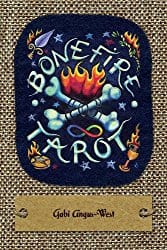
Bonefire Tarot, by Gabi Angus-West
Schiffer, 9780764351921, 196 pp., 2016
Tarot cards are full of symbology, and so are tattoos. Bonefire Tarot by Gabi Angus-West combines the two in a colourful deck that is stylized after the classic Sailor Jerry tattoo style. These beautifully-illustrated cards make for a strong intuitive deck for an experienced reader.
I received the full kit version of this deck. It comes in a very attractive, and sturdy box adorned with a burlap design. It invokes visions of cigar boxes that hearkens back to its sort of handmade feel. Inside is a full-colour book and the cards themselves.
The cards are larger than standard tarot decks and in a square shape. This makes them a bit difficult to shuffle, but that’s a minor concern. The deck itself is beautiful. The cards are all vibrantly coloured with unique illustrations. Angus-West maintains her artistic vision and style throughout the deck, skillfully weaving symbols into each card to connect them subtly to each other.
This is a Rider-Waite-Smith (RWS) deck, but while the cards are built on that imagery, they also depart from it. Although you can see echoes of the original deck, the images are really their own take on them. For example, the Five of Wands (a card that usually depicts a conflict between five beings with rods or staffs), in this deck shows a childish game of conkers that causes sparks — lighting the pine cones (this deck’s stand-in for wands).1 Unlike the Rider Tarot, understanding these cards takes more of a narrative investment, and a deeper understanding of the images presented.
Related: See Xenia’s article, “Sacred tattoos: Temporary skin, permanent mark,” for more information about sacred tattoos.
Each card features many symbols from a variety of cultures, including tattoo culture, to communicate the meaning of the card. In fact, this level of information can be overwhelming, especially to new readers who are unfamiliar with tarot.
The book accompanying the Bonefire Tarot offers a handy glossary at the end that gives brief descriptions of the different symbols which are displayed on the cards. In fact, this book is remarkably well done in terms of helping to understand the cards themselves.
The book is in full colour and each card is shown with its description, which is nice if you want to study this deck on the go. There are quick facts on the basic meaning of the card, and then a more in-depth reading that explains the depiction and changes the artist made from the RWS.
The first part of the book contains essays by the artist on the creation of the deck wasn’t very useful, but this section is short and can be skipped. The bulk of the book concerns the description of the cards, and includes three spreads to use with this deck. It includes a one-card draw focused on speaking to the ancestors, a Beltane-inspired take on a three-card draw, and a larger eight-cards spread.
Despite my excitement for these cards, I actually had a bit of trouble connecting with them. I attempted a number of readings with them, but there was something that just wasn’t clicking with them as I tried to make connections between the cards and my understanding of them.
Finally, I sat down and asked them how they wanted me to use them, and made a startling discovery. These cards are covered with imagery, but the purpose is not to read every image there, nor is it to pore over the information in an attempt to unlock some hidden truth. The point of these cards is to grab a handful of the images, and draw your meaning from there. When I went back and attempted readings based only on the things that grabbed my attention in the cards, it went much smoother. My interpretations were aligned with the information from the book and the readings were quick and entertaining.
To that end, I think this deck would be a nice one to use in client readings, especially for people who read at parties and festivals. With such a wealth of information on each card, it would be possible to give worthwhile readings from simple spreads. In addition, the really graphic art style is fun and unique which can help draw clients into the reading.
Related: For more, see Donyae Coles’ article, “Reading tarot professionally at parties and events.”
However, I would not recommend these cards beginners. There is so much going on in the images, using these may be overwhelming for people who are new to tarot or not comfortable with reading in an intuitive manner. Although they can be used with basic RWS meanings, you would be missing out on a lot of deep insight by being limited to only reading in this way.
Overall, Bonefire Tarot is a solid deck. It is beautiful and works well for a variety of readings. Though not suited for people just starting out, for the advanced tarot reader this deck could be a welcome treat.
- Conkers is a British game where two chestnuts are spun towards each other. The winner is the one who knocks the other out of the circle. Similar to marbles in a way. [↩]









